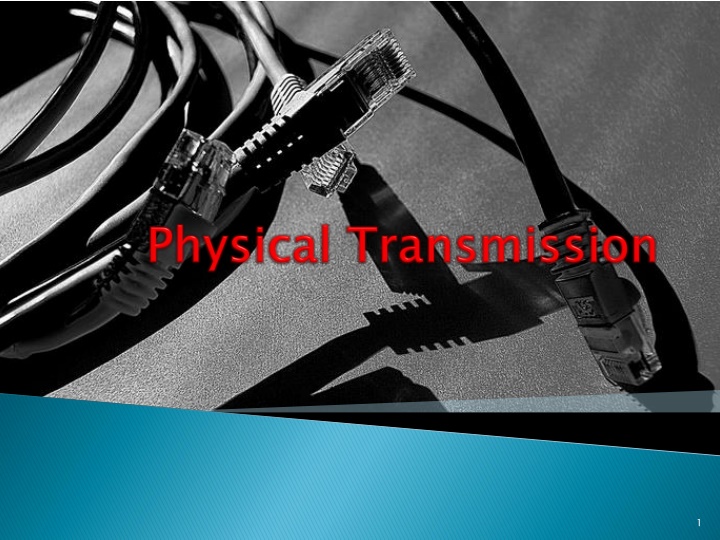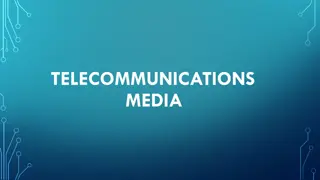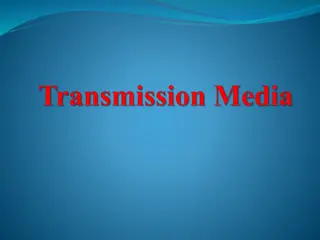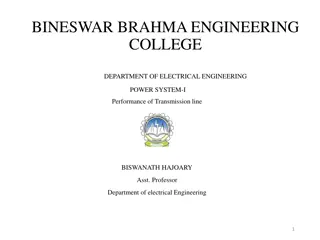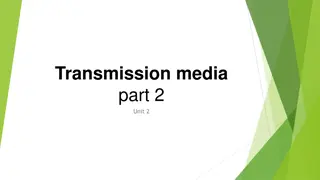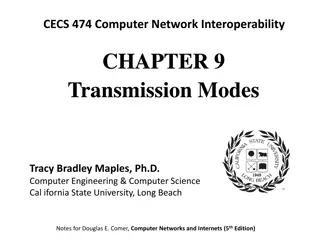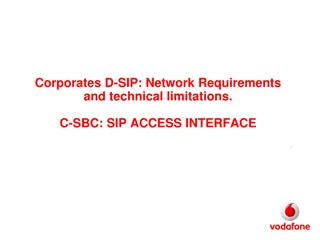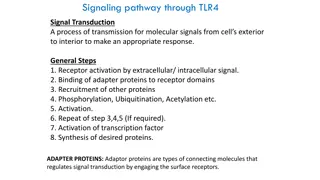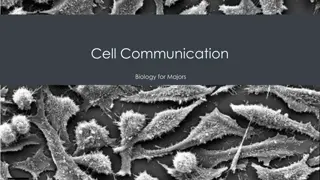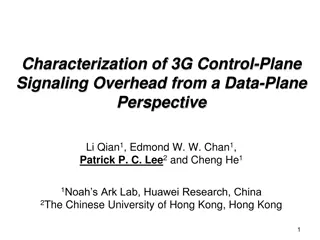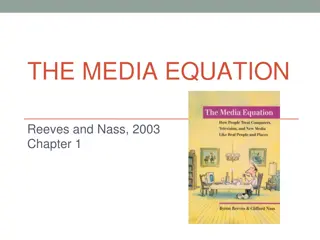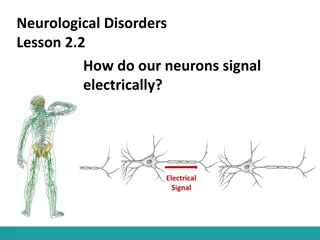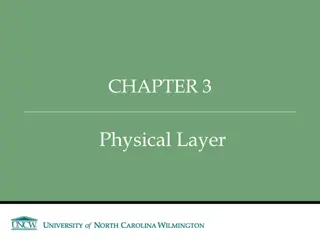Transmission Media and Signaling Techniques Overview
In this informative content, various transmission media such as coaxial cable, UTP wire, fiber optic, and more are discussed, along with signaling techniques like radio waves, microwave, and laser. The content explains how data is sent and received through different invisible waves, offering insights into the advantages and applications of each type of transmission medium. It covers electromagnetic spectrum division, characteristics of radio waves, microwave waves, infrared waves, satellite communication, and laser technology. The emphasis is on understanding the properties, uses, and limitations of each transmission medium and signaling technique in modern networks.
Download Presentation

Please find below an Image/Link to download the presentation.
The content on the website is provided AS IS for your information and personal use only. It may not be sold, licensed, or shared on other websites without obtaining consent from the author.If you encounter any issues during the download, it is possible that the publisher has removed the file from their server.
You are allowed to download the files provided on this website for personal or commercial use, subject to the condition that they are used lawfully. All files are the property of their respective owners.
The content on the website is provided AS IS for your information and personal use only. It may not be sold, licensed, or shared on other websites without obtaining consent from the author.
E N D
Presentation Transcript
Coaxial cable UTP Wire (guided) Twisted Pair STP Fiber Optic Transmission Media Radio waves Microwave Physical Transmission Wireless (unguided) Infrared Baseband Transmission Satellite Signaling Techniques Laser Broadband Transmission 2
Transmission is sent and received through invisible waves Less expensive than copper or fiber optic lines. Allows the user to move freely around the office or campus and still remain connected to the network Fastest-growing segment of network media today 4
Transmission and reception via antenna Directional Signals are sent in one direction. Use directional antennas - point to point line of sight communications Omnidirectional Signal spreads in all directions Can be received by many antennas 5
Electromagnetic Spectrum divided to : Radio waves Microwave waves Infrared waves Satellite Laser 6
Radio waves: It is electromagnetic waves ranging in frequency between 3 KHz and 1 GHz. Are omnidirectional, they propagate in all directions. They can penetrate through walls. Use omnidirectional antenna Microwave waves: It is electromagnetic waves ranging in frequency between 1 and 300 GHz. faster than radio Are unidirectional Higher frequency ranges cannot penetrate walls. Need unidirectional antenna 7
Infrared waves: transmits data using infrared (IR) light. Its frequencies from 300GHz to 400 THz. Used for short-range communication Since it have a high frequency, it cannot penetrate walls. Satellite: This is a space station that receive microwave signals from an earth-based station, amplifies the signals, and broadcasts the signal back over a wide area to any number of earth-based station. 8
Laser: Unidirectional, like microwave Higher speed than microwave Uses laser transmitter and receiver at each end Point-to-point, typically between buildings Can be adversely affected by weather 9
Copper wire is mature technology and inexpensive; maximum transmission speed is limited Glass fiber: Higher speed More resistant to electro-magnetic interference Spans longer distances Requires only single fiber More expensive Radio and microwave don't require physical connection Radio and infrared can be used for mobile connections Laser also does not need physical connection and supports higher speeds 10
Analog data: continuous as human voice. Analog data: refers to information that is Digital data: states. Data stored in computer memory in forms of 1s and 0s. Digital data: refers to information that has discrete To be transmitted, data (analog or digital) must be transformed to electromagnetic signals. 12
Signals can be analog or digital. Analog signals can have an infinite number of values in a range Digital signals can have only a limited number of values. 13
Bit Rate: expressed in bits per second (bps). Bandwidth: The difference between the highest and the lowest frequencies of a signal. Bit Rate: the number of bits sent in one second, Bandwidth: 14
Bit rate and bandwidth are proportional to each other. If we need to send bits faster, we need more bandwidth. Bandwidth also measures the capacity of information that a medium can carry. Analog bandwidth: Hertz Digital bandwidth: bits per second (bps) 15
Coaxial cable UTP Wire (guided) Twisted Pair STP Fiber Optic Transmission Media Radio waves Microwave Physical Transmission Wireless (unguided) Infrared Baseband Transmission Satellite Signaling Techniques Laser Broadband Transmission 16
There are two ways that a signal is sent across a network medium: I. Baseband Transmission II. Broadband Transmission 17
Baseband: A type of digital data transmission in which each medium (wire) carries only one signal, or channel, at a time. Uses Digital Signaling Single Frequency Transmits Bi-directionally Uses Repeaters 18
Broadband: enables a single wire to carry multiple signals at the same time. Uses Analog Signaling Multiple Frequencies Transmits Uni-directionally Uses Amplifiers 19
An electronic device that increases the power of the signal. Unlike repeaters, amplifiers strengthen the signal along with its noise. 20
an electronic circuit that receives a signal and retransmits the same signal with a higher power. Therefore, a repeater consists of a signal receiver, an amplifier and a transmitter. The main purpose of a repeater is to extend the length of the network transmission medium beyond the normal maximum cable lengths. 21
Difference between Amplifier and 1. Amplifier is used to magnify a signal, whereas repeater is used to receive and retransmit a signal with a power gain. Difference between Amplifier and Repeater: Repeater: 2. Repeater has an amplifier as a part of it. 3. Sometimes, amplifiers introduce some noise to the signal, whereas repeaters contain noise eliminating parts. 22
Signals travel through transmission media which are not perfect. This means that the signal at the beginning of the medium is not the same as the signal at the end of the medium. In other words, the signal has changed over the medium.. 24
Impairment Causes Attenuation Distortion Noise 25
Distortion : shape. Sometimes caused by dirty or corroded connectors or bad cables Distortion : means that signal changes its form or Receiver Sender 27
is a general term for unwanted (and, in general, unknown) modifications that a signal may suffer during capture, storage, transmission, processing, or conversion, caused when a strong external signal interferes with a signal. 28
Thermal noise : the random motion of electrons in a wire which creates an extra signal not originally sent by the transmitter. Induced noise: Comes from sources such as motors and appliances Crosstalk noise: Is the effect of one wire on the other Impulse Noise: is a spike ( a signal with high energy in a very short time) that comes from power lines, lighting and so on. 29
